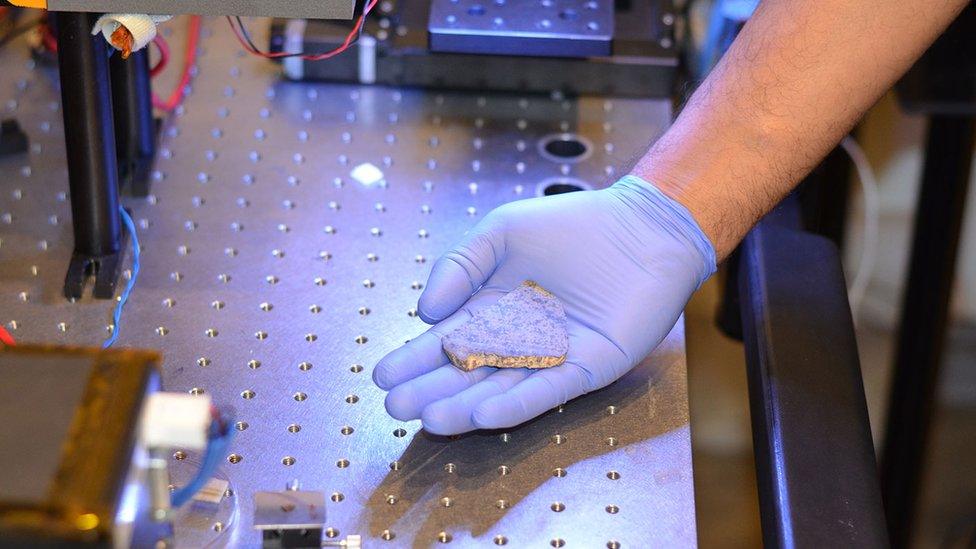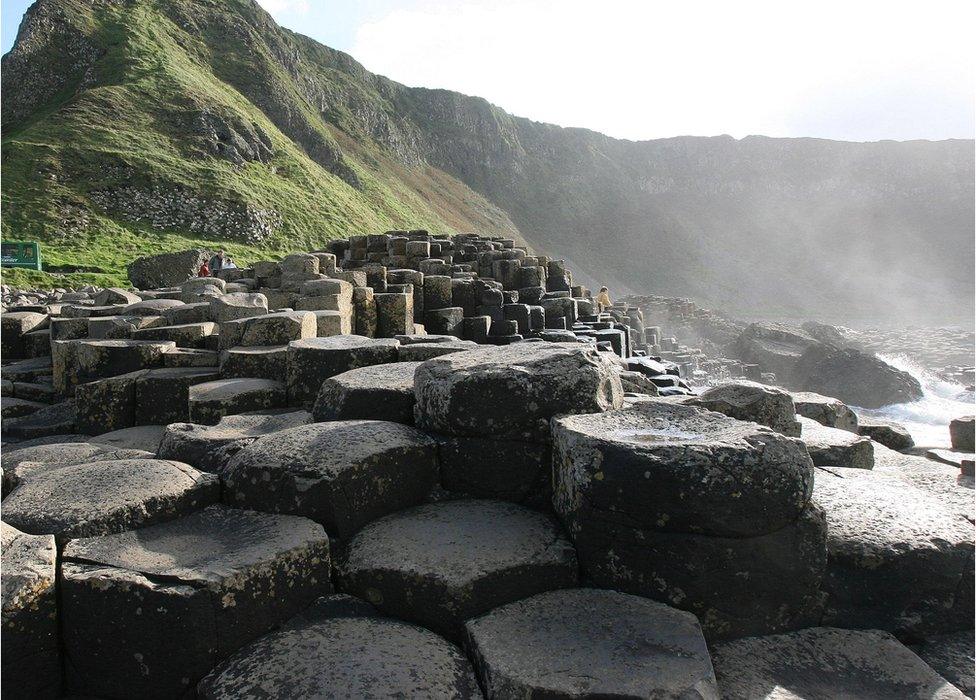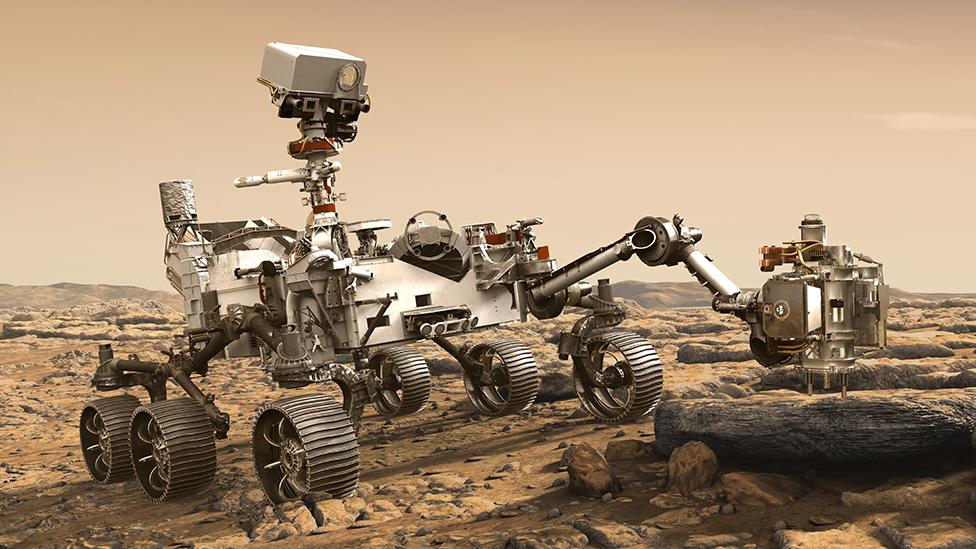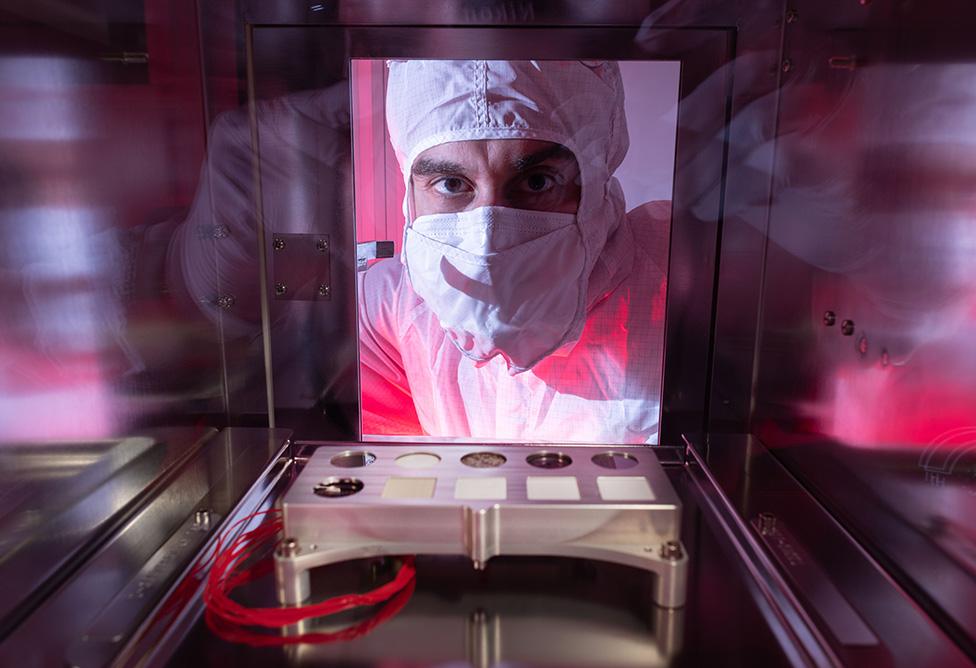Nasa Mars rover: Meteorite to head home to Red Planet
- Published

A section of the Sayh al Uhaymir 008 meteorite which was found in Oman in 1999
A small chunk of Mars will be heading home when the US space agency launches its latest rover mission on Thursday.
Nasa's Perseverance robot will carry with it a meteorite that originated on the Red Planet and which, until now, has been lodged in the collection of London's Natural History Museum (NHM).
The rock's known properties will act as a calibration target to benchmark the workings of a rover instrument.
It will give added confidence to any discoveries the robot might make.
This will be particularly important if Perseverance stumbles across something that hints at the presence of past life on the planet - one of the mission's great quests.
"This little rock's got quite a life story," explained Prof Caroline Smith, head of Earth sciences collections at the NHM and a member of the Perseverance science team.
"It formed about 450 million years ago, got blasted off Mars by an asteroid or comet roughly 600,000-700,000 years ago, and then landed on Earth; we don't know precisely when but perhaps 1,000 years ago. And now it's going back to Mars," she told BBC News.
Prof Caroline Smith: "It gives me a tingling feeling to hold something that came from Mars"
Discovered in the deserts of Oman in 1999, the meteorite, known as Sayh al Uhaymir 008, or SaU 008, external, is a classic piece of basalt - very similar to the type of igneous rock you will find, for example, at Giant's Causeway in Northern Ireland.
It contains lots of pyroxene, olivine and feldspar minerals. And it's this well-studied chemistry, together with the meteorite's textures, that make it so useful for Perseverance.
The rock has been put in a housing, along with nine other types of material, on the front of the rover where it will be scanned from time to time by the Sherloc instrument, external.
This is a tool that contains two imagers and two laser spectroscopes, which together will investigate the geology of the rover's landing site - a 40km-wide crater called Jezero.
Satellite images suggest the bowl once held a lake, and scientists consider it to be one of the best places on Mars to try to find evidence of past microbial activity - if ever that took place.

Giant's causeway: The World Heritage site is made from columns of basalt rock

Sherloc will study the local rocks and soil, looking for signatures of ancient biology.
What scientists don't want, however, is to have what they think is a "eureka moment" only to then realise Sherloc had developed some systematic error in its observations.
"We'll look at the calibration target in the first 60-90 days and perhaps not again for six months because we think the instrument is really very stable," said Dr Luther Beegle, Sherloc's principal investigator from Nasa's Jet Propulsion Laboratory.
"But if we start seeing interesting things on the surface of Mars that we can't explain in the spectra, then we'll look back to the calibration target to make sure that the instrument's working correctly.
"I think the best we're going to be able to do from a scientific perspective is identify what we would call a 'potential bio-signature'.
"I don't think we'll ever be necessarily 100% sure because that's a hard measurement to make, which is why the sample-return aspect of Perseverance is so important."

Artwork: The Sherloc instrument is in the turret on the end of the robotic arm
The rover will package its most interesting rock samples into small tubes that will be left on the surface of Mars for retrieval and return to Earth by later missions.
Prof Smith is hopeful she'll get to work on this material, which could come back in the next 10-15 years.
The NHM expert is on an international panel that will determine how best to handle the extra-terrestrial rocks.
"I'm actually leading the curation focus group," she told BBC News. "By this time next year, we should have a really good plan for the sort of building we will need, the types of processes that will be happening in that building, and how we'll actually start curating the samples and making them available to scientists for study."
How long does it take to get to Mars and why is it so difficult?
Researchers will have a much better chance of confirming life on Mars if they can assess the evidence using all the analytical tools available in Earth laboratories, as opposed to just the small suite of instruments carried by a robot rover.
Nasa's Perseverance rover is scheduled to lift off on a United Launch Alliance Atlas rocket from Cape Canaveral, Florida, during a two-hour window on Thursday that begins at 07:50 local time (11:50 GMT; 12:50 BST).
The slice of SaU 008 won't be the only Martian meteorite on board. The rover's SuperCam instrument will have its own piece of Mars rock, again to act as a calibration target.

The meteorite is one of several calibration items to be employed by Sherloc. Others include materials that could be used in the spacesuits worn by future human explorers of Mars

Jonathan.Amos-INTERNET@bbc.co.uk, external and follow me on Twitter: @BBCAmos, external